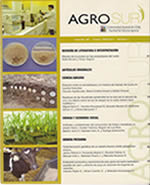Soils associated to three important grazing vegetal communities in South Patagonia
Main Article Content
Abstract
South Patagonia (south of 53°S) has long been famous for its rugged terrain, extremely oceanic climate and often hydromorphic vegetation and soil. Volcanism, tectonic and glacial processes are imprinting their actions along a territory, with vegetation-soil patterns that has been known since Darwin's time. Soil fertility and rainfalls seem to control the overall floristic gradient in a simple structure, often changed by anthropic disturbations. The goal of this study was to establish general relationships between three major plant communities (Empetrum rubrum or "murtilla", Festuca gracillima or "coirón", and hydromorphic Poas or "vegas") and the properties of fluvio-glacial mineral soils that support them. Soil under "murtilla" shows more constraints to plant growth, determined by a low pH, high aluminum activity and low amounts of non acid cations.

